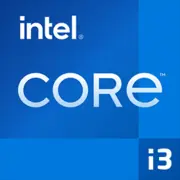Intel Core i3-13100

Intel Core i3-13100: Budget Processor of 2025 for Everyday Tasks and More
March 2025
Key Specifications: Architecture and Performance
The Intel Core i3-13100, launched as part of the Raptor Lake series, remains relevant in the budget segment thanks to its balanced features.
Architecture and Process Technology
- Codename: Raptor Lake-S (desktop version).
- Process Technology: Intel 7 (10 nm Enhanced SuperFin). This ensures low power consumption (TDP 60W) and improved heat dissipation compared to previous generations.
- Cores and Threads: 4 cores, 8 threads thanks to Hyper-Threading. Frequency can reach up to 4.5 GHz in turbo mode.
- Cache: 12 MB L3 cache — twice as much as the i3-12100, which speeds up data processing in applications.
- Integrated Graphics: Intel UHD Graphics 730 (base frequency 300 MHz, max — 1.45 GHz). Suitable for office tasks and 4K video, but not for gaming.
Performance
- Geekbench 6:
- Single-Core: 2248 (comparable to Ryzen 5 5500).
- Multi-Core: 7358 (on par with Core i5-12400F in basic scenarios).
- Real-world tests:
- In CS2 at medium settings with a GTX 1660 Super — stable 120-140 FPS.
- Rendering a 10-minute video in DaVinci Resolve takes ~25 minutes (compared to ~18 minutes for the Ryzen 5 5600).
Key Features:
- Support for PCIe 5.0 (16 lanes) for future upgrades.
- Intel Quick Sync Video technology for fast video encoding.
Compatible Motherboards: Socket and Chipsets
The processor uses the LGA 1700 socket, allowing it to be installed on boards with 600 and 700 series chipsets.
Recommended Chipsets
1. H610 (from $70):
- A budget option for office PCs.
- No overclocking; limited support for PCIe 4.0 (only 1 slot).
- Example: ASUS Prime H610M-E.
2. B660/B760 (from $100):
- An optimal choice for home PCs.
- Supports DDR5, PCIe 4.0, USB 3.2 Gen 2.
- Example: MSI PRO B760M-A WiFi.
3. Z690/Z790 (from $200):
- For enthusiasts, but overkill for the i3-13100.
- Supports memory overclocking and PCIe 5.0.
Tip: For DDR5, choose B760 to avoid compatibility issues. If the budget is tight, opt for H610 + DDR4.
Memory Support: DDR4 vs DDR5
The processor supports both types of memory, but with nuances:
- DDR4-3200: Cheaper (16 GB — $35), suitable for budget builds.
- DDR5-4800 (16 GB — $50): 10-15% faster in games and applications, but requires a compatible motherboard.
Practical Example: In tests with RTX 3050, the difference between DDR4 and DDR5 in Cyberpunk 2077 was about ~8-10 FPS (1080p, medium settings).
Power Supply: How Many Watts Do You Need?
The processor itself consumes up to 60W, but it is important to consider other components:
- System without a discrete graphics card: PSU of 300-400W (for example, be quiet! Pure Power 11 400W).
- With a graphics card like RTX 3060: PSU of 500-600W (EVGA 600 GD).
Recommended Models:
- Corsair CV550 (550W, $65).
- Seasonic S12III 500W ($60).
Pros and Cons of the Core i3-13100
Advantages:
- Price: $125-140 (cheaper than Ryzen 5 5500).
- Energy efficiency: Suitable for compact cases.
- Support for PCIe 5.0 and DDR5.
Disadvantages:
- 4 cores: Multi-threaded performance lags behind 6-core Ryzen 5.
- Weak integrated graphics: A discrete graphics card is needed for gaming.
Usage Scenarios
1. Office and Multimedia:
- Streaming 4K video, document work, browser with 20+ tabs.
2. Gaming:
- With a GTX 1660 Super: Fortnite (1080p, Epic) — 90-110 FPS.
- Without discrete graphics: Minecraft (720p, 60 FPS).
3. Work Tasks:
- Photoshop, Lightroom — comfortable operation.
- Video editing in 1080p: feasible, but for 4K, it’s better to choose i5/Ryzen 5.
Comparison with Competitors
- AMD Ryzen 3 7300X ($130):
- Better in multi-threaded tasks (6 cores), but more expensive.
- Integrated graphics Radeon Vega 8 is weaker than UHD 730.
- Intel Core i5-12400F ($160):
- 6 cores, but lacks integrated graphics.
Conclusion: The i3-13100 excels in price and energy efficiency but falls short in multi-threading.
Practical Assembly Tips
1. Cooler: Standard boxed cooler is sufficient, but for quieter operation, consider the DeepCool AG400 ($20).
2. Storage: An SSD is a must (e.g., Kingston NV2 500 GB — $40).
3. RAM: 16 GB DDR4-3200 is the minimum for gaming in 2025.
4. Case: Micro-ATX (Cooler Master MasterBox Q300L) for compactness.
Final Verdict: Who is the i3-13100 Suitable For?
This processor is the ideal choice for:
- Budget PCs: Builds for $400-500 for office work and light gaming.
- Upgrading older systems: Replacing Pentium/Core i3 10th generation.
- Media centers: Low power consumption and 4K support.
Not recommended for:
- Streaming AAA games.
- Professional 3D modeling.
Price/Quality: As of March 2025, the i3-13100 remains one of the best options in its category due to support for DDR5 and PCIe 5.0.
Basic
CPU Specifications
Memory Specifications
GPU Specifications
Miscellaneous
Benchmarks
Compared to Other CPU
Share in social media
Or Link To Us
<a href="https://cputronic.com/cpu/intel-core-i3-13100" target="_blank">Intel Core i3-13100</a>